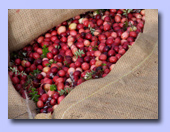|
Lesson Plan:
Overview
Background
Materials
Preparation
Step-by-Step
|
- Begin the lesson with an invitation to students to get to know cranberries. Ask them to generate a list of things that come to mind when they think of cranberries. It may make sense to begin by polling the class to see who has/has not seen a cranberry before, especially if you are not from a cranberry growing region.
- Frame the lesson’s exploration by pointing out that often we do not have a chance to really get to know something through all of our senses, but that they will get to know cranberries in this way.
- Divide the class into small groups (3-4 students). Give each group a small handful of fresh, whole cranberries with a cup of water. Invite them to explore them for a few minutes, in any way they like, so long as they keep the cranberries confined to their group area.
- Guide students to explore the cranberry through each sense. Provide a few minutes for each sensory exploration and then collect student group observations on the class chart.
While students are exploring, encourage them to make careful observations by asking guiding questions such as those suggested below.
- Take a look at your cranberry. What are the shades and colors, shapes, dimensions you see? What details do you notice? Will it float? How are any two cranberries alike? Different? Slice one cranberry in half. What do you see?
- Touch and hold and move the whole cranberries around in your hands. What does a cranberry feel like? How would you describe the texture? Is the berry firm, smooth? Is it the same everywhere? Is it heavy, lightweight? How would you know you had a cranberry in your hand if you were blindfolded? What does the open cranberry feel like?
- Smell the cranberry. How would describe the smell? Does it remind you of anything else? What? Is it a strong odor? Mild? Sharp? Floral? Sweet-smelling?
- What might you do to be able to hear the cranberry? (Allow groups to make suggestions and try them.) What sounds do they make? Cut a second cranberry in half. Is there a sound it makes when it is cut? After it is cut, what sounds does it make? (Cranberries make audible sounds as they roll, shake, and are squeezed. [Additional resources: video showing bouncing cranberries.]
- Taste a whole cranberry. [NOTE: Make sure students are tasting whole cranberries that have not yet been handled by others.] What does it taste like? Sharp? Sweet? Bitter? Tart? Meaty? Fruity? What else have you tasted that is like this?
- Introduce to students the fact that up until now, they have explored a raw, whole, fresh cranberry. Discuss with them that they may be familiar with processed cranberry products, as well. (You may wish to discuss this from a technological viewpoint, generating other examples of raw materials and their processed products.) Tell students that for the rest of this lesson, you will explore the following questions:
- How are some cranberry-based, processed products similar to and different from raw, whole cranberries?
- Why might people feel it is worthwhile or valuable to process the cranberry product?
- Provide each group with two cranberry products in small cups or on video, as appropriate to each group, and sampling cups and serving ware so that each student can taste the item (as appropriate). Have students explore each product as they did the cranberry. Each group should complete a copy of Observation Chart Two, and then report out, while you record their responses on the class version of the chart.
- Invite students to speculate: What might account for some of the differences in their observations? (Processing, sweetening). Processing cranberries takes time, energy, and money. Why would people bother?
- Wrap up the discussion by reminding students that they have explored a raw material and some of the products that come from that material. Ask: Where does this raw material come from? This is a good time to preview the idea that cranberries grow on cranberry vines, grown on special farms—cranberry bogs, and that soon they will be exploring the cranberry bog.
- Finally, invite students to share questions they have about cranberries and record. You may wish to assign listing of questions as a journal prompt, and then ask students to report one or more questions out to the group, or you might prefer to run this as a small group discussion/brainstorm, with a large-class report-out.
|







